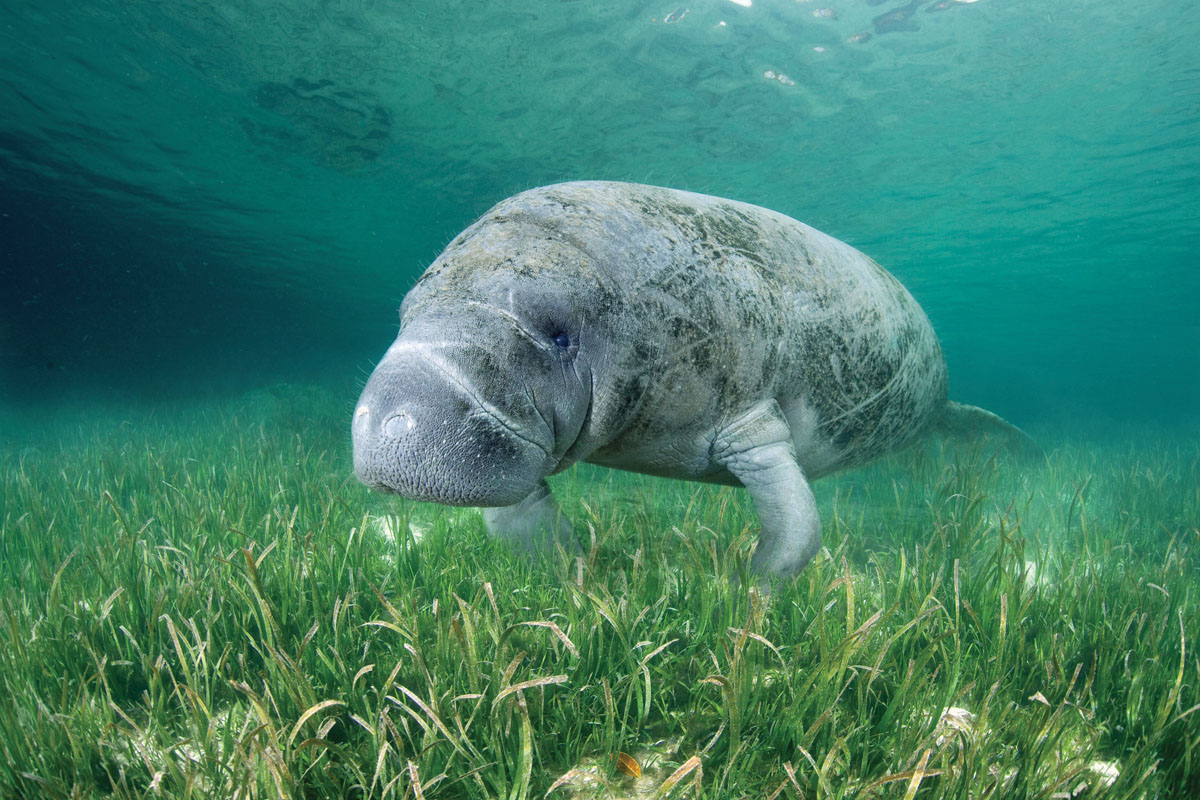We have much more to do and your continued support is needed now more than ever.
Manatees and Meadows: The Remarkable Seagrass Habitats of the Florida Panhandle
If you live in Escambia, Santa Rosa, or Okaloosa County, you may have seen us at a boat ramp or fishing pier giving out polarized sunglasses and talking to anyone who will listen about local manatees. We are Panhandle Manatee: a collaborative program between NWF, Pensacola and Perdido Bays Estuary Program, and Dauphin Island Sea Lab. Our Mission? Educate the public about manatees migrating to the Florida Panhandle during the summer, how to report manatee sightings, and best boating practices. Our Secret Goal? Educating the public about the importance of seagrass meadows and promoting ways to protect these critical ecosystems.
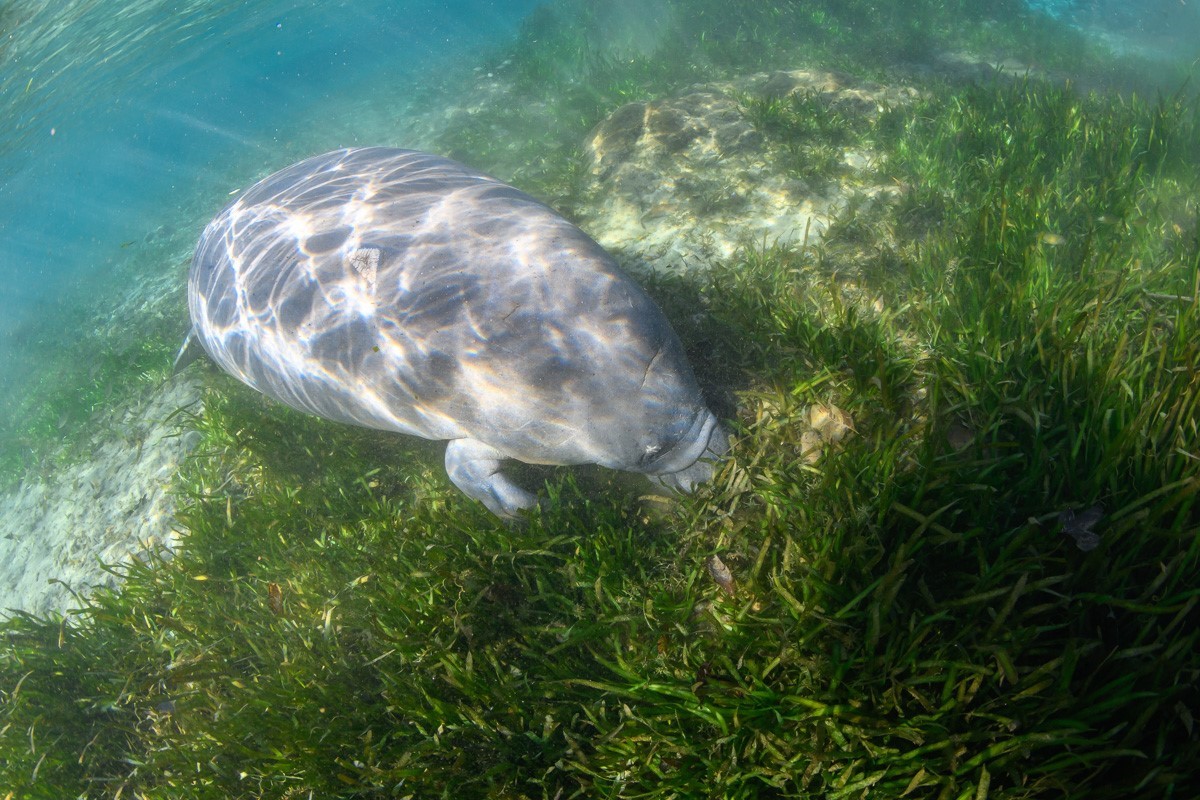
Seagrass meadows, also known as seagrass beds, are underwater havens formed by dense clusters of seagrasses. They act as nurseries of the sea by providing habitat, food, and shelter to many juvenile fish and small invertebrates. Additionally, seagrass beds are well known for providing crucial habitat for the Florida manatee. Manatees are large, herbivorous marine mammals that need to eat seagrass and other aquatic plants to survive–and they need to eat a LOT of it!
While seagrasses may not be as charismatic as manatees, they serve many important roles: water filtration, sediment stabilization, carbon storage, and food and shelter for wildlife. If it were not for seagrass meadows, manatees would starve–a problem we are already seeing throughout Florida, such as in the Indian River Lagoon.

Let’s back up for a minute, what exactly are seagrasses?
Seagrasses are flowering plants with roots, stems, and leaves. They are often confused with seaweeds, however, the two are entirely different. Seaweeds, or macroalgae, lack the complexity of true plants like seagrass. Seaweeds attach themselves to existing surfaces, while seagrasses have roots that grow into the sediment and reduce erosion. Both seaweeds and seagrasses absorb sunlight, but only seagrasses have leaves and roots that can draw nutrients from the sediment and water. Seagrasses grow underwater on the sediment but require light for photosynthesis, therefore they are typically found in shallower waters, such as bays and estuaries.
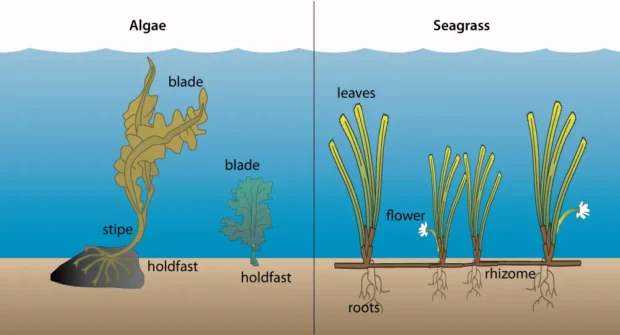
The shallow coastal zones of the Perdido and Pensacola Bay Systems are dominated by Shoal Grass (Halodule wrightii), Turtle Grass (Thalassia testudinum), and Manatee Grass (Syringodium filiforme). Click here to learn more about the different seagrasses in our area and how to identify them.


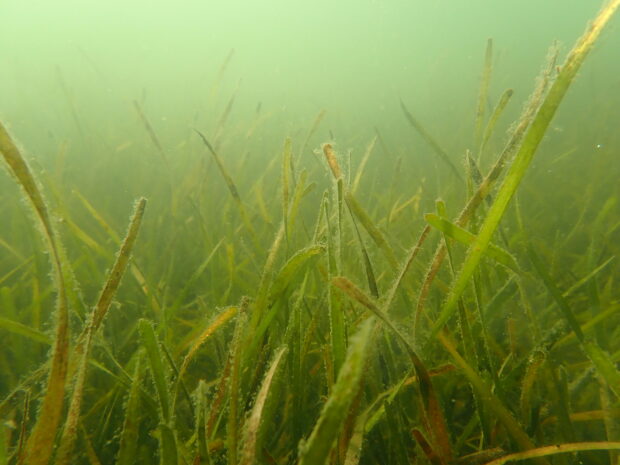
But…why are seagrasses important to our estuaries?
Seagrass beds are brimming with diverse life–from crabs, shrimp, and scallops, to sea turtles, sharks, and manatees. Without seagrasses, we would not have the seafood that we love to eat, because seagrasses are important nursery grounds for approximately 70% of Florida’s fishery species, including the Gray Snapper (Lutjanus griseus), and the Red Drum (Sciaenops ocellatus).

Seagrasses also improve water clarity by trapping fine sediments and particles suspended in the water column, and improve water quality by filtering out pollutants from runoff.
During hurricane season, seagrasses are vital to preventing erosion and mitigating storm damage; their dense roots and rhizomes form a secure mat, which holds sediment in place.
“Although seagrasses account for less than 0.2% of the world’s oceans, they sequester approximately 10% of the carbon buried in ocean sediment annually (27.4Tg of carbon per year).” – The Blue Carbon Initiative
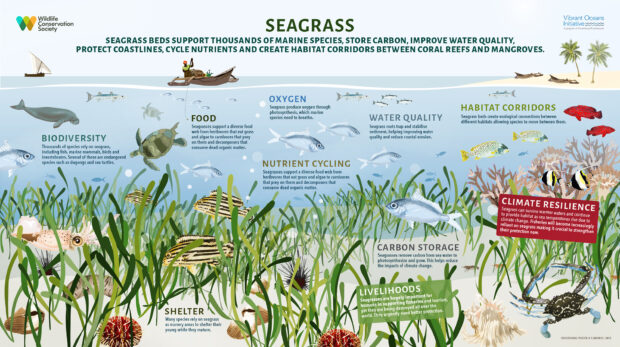
State of Seagrasses in the Pensacola and Perdido Bays
Poor development practices can harm seagrasses by increasing the amount of sediments that run off into our waterways. The increased sediments lead to higher turbidity in the water, meaning that less sunlight is able to penetrate through the water column to reach the seagrasses. Without sunlight, seagrasses cannot photosynthesize and won’t survive.
In addition to sediments washing down into our waterways, excess nutrients from fertilizers that runoff into the Bay can impact seagrasses. Algae thrive from the nutrients in fertilizer and this growth can cause algal blooms that block out sunlight, impeding seagrass growth.

Over the last five decades, population growth and urban development in the Pensacola and Perdido Bay watersheds has contributed to the degradation of our seagrass beds. Between 1950 and 1980, there was approximately a 95% decline of seagrasses in our western Panhandle area. However, habitat monitoring and conservation efforts have increased due to the highly public fish kills that Pensacola experienced around the same time as the major decline in seagrass beds.
While our seagrass beds are still recovering from the decades of declines, mapping data from 2003 to 2010 suggests that there has been a 51% increase of seagrass in the Pensacola Bay, which is equivalent to ~542 acres. The Pensacola and Perdido Bays Estuary Program (PPBEP) has identified seagrass as a priority within the Program’s Comprehensive Conservation and Management Plan (CCMP). This effort includes assessing seagrass health and distribution, as well as developing a restoration strategy for long-term protection and recovery across Pensacola and Perdido Bays. PPBEP funded seagrass surveys in 2022 to assess the extent, distribution, and condition of seagrass species in both bay systems. These findings will be available in the 2025 State of the Bays Report.
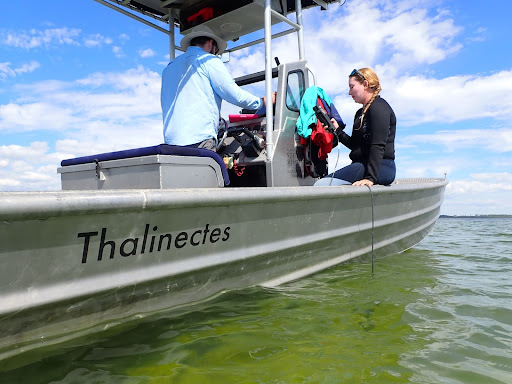
One of the best ways to learn about an ecosystem and to monitor its health is to get out there! Consider volunteering with Eyes on Seagrass, a state-wide citizen science program with Florida Sea Grant that is led here locally in Escambia County. Reach out to Rick O’Connor at roc1@ufl.edu for more information.
How can we be Seagrass Safe in Florida?
According to FWC, as of 2022, there are more than 1 million registered vessels in Florida. With an increasing number of boaters out on the water every year, it is imperative to the preservation of seagrass meadows to practice safe boating. Poor boating practices can cause propeller scarring and ship grounding, leading to seagrass degradation and loss. It can take anywhere from a few months to several years for seagrasses to recover after scarring, contributing to the loss of food and habitats for manatees and the loss of economical and ecological services for the Panhandle community.

These detrimental effects are avoidable by practicing seagrass-safe boating:
- Avoid motorized boating in seagrass beds when possible. There are maps available to show you where the seagrasses are, but another way to tell is by wearing polarized sunglasses and avoiding the dark spots in the water. Utilizing navigation channels and staying in deeper water are great ways to avoid seagrasses.
- If you find yourself already in a seagrass bed, or if you are unsure, trim the motor up and idle to a deeper depth of at least 3 ft before getting up on plane. A tell-tale sign that you are in a seagrass bed is a plume behind your boat!
- If you are aground in a seagrass bed, push the boat to a seagrass safe depth before engaging the motor.
These are the best boating practices for keeping our seagrasses safe, and preventing costly repairs for your boat! An easy way to remember to practice safe boating is to use our motto: Go Slow Where the Seagrasses Grow.
Being a steward of seagrasses means that you are helping to protect our beloved white sandy beaches, supporting seafood and tourism economies, and preserving the habitat of all of the animals that call these seagrass meadows home–such as our Florida manatees!
Remember, if you are lucky enough to spot a manatee in our area (or anywhere that manatees occur) please report all manatee sightings to Panhandle Manatee by visiting our website or calling toll-free at 1-866-493-5803.
